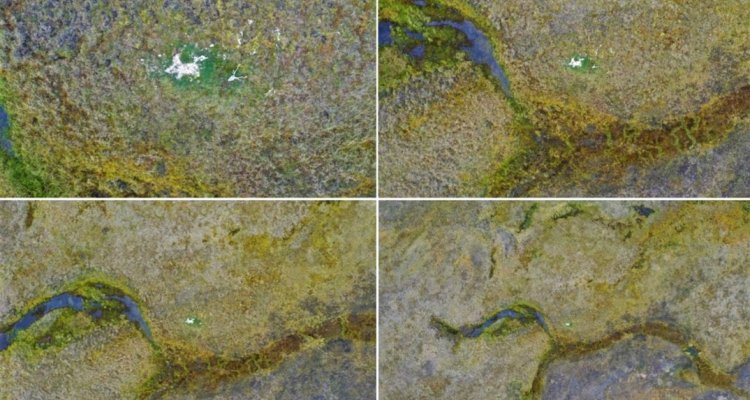
Thesis subject
MSc thesis topic: Detecting reindeer carrion in the Arctic tundra of Svalbard
Dead organic matter comprises the basal trophic level of many food webs globally and promotes biodiversity and ecosystem stability. Dead organic matter from animals, or carrion, is a distinct and relatively rare component of the detrital pool, but represents a high quality ecological resource. Whereas the role of plant decomposition in ecosystem functioning has long been recognized, the ecological significance of carrion in ecosystems has been largely overlooked.
Key research papers in the early 2000’s, however, marked the onset of a rapid increase in carrion research, and the ecological relevance of carrion is becoming broadly acknowledged. In terrestrial ecosystems, carrion is most apparent when originating from larger vertebrates, and the environmental context (e.g. climate) determines how carrion affect their surroundings. Despite carrion being acknowledged as a critical energy transfer pathway that affects individuals, populations, and ecosystems, its true ecological significance remains unknown, because of the fundamental but unanswered question: How much carrion biomass is available in ecosystems?
Quantifying carrion biomass in ecosystems is one of the greatest challenges in carrion ecology, as it comprises a rare and unpredictable resource of ephemeral nature. Field methods for systematically estimating carrion biomass (e.g. bone surveys) have proved very valuable, but are labour intensive and spatiotemporally restricted to the purpose of a specific study. In this project, we will use high-resolution optical remote sensing combined with deep learning techniques to detect and estimate vertebrate carrion biomass at the ecosystem scale. This is based on the rationale that, albeit ephemeral in nature, large vertebrate carrion leaves a distinct mark on the landscape that can be visible for many years (‘cadaver decomposition islands’ or CDIs), particularly in colder and nutrient poor environments such as the Arctic tundra. We capitalize on a unique dataset that includes >600 geo-referenced individually-aged and -sexed reindeer (Rangifer tarandus) cadavers (2008-present) in Adventdalen, Svalbard. These data are collected by the Norwegian Polar Institute (NPI) and are available through a collaboration with Nord University. This dataset provides the ‘ground truth’ for building and validating spatially explicit models for detecting CDI dynamics based on imagery from various platforms and sensors (e.g. field spectroradiometers, multispectral drones, hyperspectral aerial imagery, very high-resolution satellite imagery). These models will then be used to estimate annual carrion biomass input over vast landscapes, and thus provide the critical data for investigating the ecological significance of carrion biomass in the food webs. We will use this approach to quantify vertebrate carrion in the Arctic tundra ecosystem, i.e. an ecosystem about which particularly little is known in terms of carrion ecology. The research will, however, provide a methodological blueprint that can easily be adapted for estimating carrion biomass of larger vertebrates in other ecosystems with sparse tree cover such as savannah or prairie.
Relevance to research/projects at GRS or other groups
This research is conducted in cooperation with Sam
Steyaert who is Associate Professor at Nord University in Norway. Sam is an
alumnus of the MGI program
Objectives
- Investigate to what extent CDIs can be detected using hyperspectral aerial data.
- Investigate to what extent CDIs can be detected using very high-resolution satellite imagery (Worldview data or similar).
- Collect spectral information at CDIs and control sites using field spectrometry and multispectral drones to characterize the spectral development of CDIs.
Literature
- Barton, P.S. et al. (2019) Towards Quantifying Carrion Biomass in Ecosystems. Trends in Ecology & Evolution 34 (10), 950-961.
- Moleón, M. et al. (2020) The Components and Spatiotemporal Dimension of Carrion Biomass Quantification. Trends in Ecology & Evolution 35 (2), 91-92.
- Brabazon, H. et al. (2020) Plants to Remotely Detect Human Decomposition? Trends in Plant Science 25 (10), 947-949.
- Carter, D.O. et al. (2007) Cadaver decomposition in terrestrial ecosystems. Naturwissenschaften 94 (1), 12-24.
- Brodrick, P.G. et al. (2019) Uncovering Ecological Patterns with Convolutional Neural Networks. Trends in Ecology & Evolution 34(08): 734-745.
Requirements
- Option to conduct fieldwork: needs discussion with supervisors. Conditions remote terrain and to handle firearms (polar bear safety – training provided).
- Experience with at least one of the following techniques: field spectrometry, drone image acquisition and processing, and multi and/or hyperspectral data management and processing.
- Experience and/or interest in machine learning for object detection.
Theme(s): Sensing & measuring; Integrated Land Monitoring